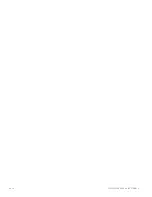
Troubleshooting
The display is not coming on.
•
Make sure there is a good set of name brand alkaline
batteries (Duracell, Energizer) in the unit.
•
If a C wire is connected, remove it and see if the thermostat
works on batteries alone (C wire may be bad).
The fan is not working in heat mode.
•
Turn the Fan button to the On position and see if it comes on.
If so, is the heat blowing? If yes, check to see that the
Gas/Elec switch is in the Elec position, if not put it there and
reset the thermostat using the reset button.
•
If the fan fails to start in the on position, there may be a
problem with the fan or fan wire (G) connection. To test,
remove the RH/RC wire and the G wire and twist them
together. The fan should come on, if not the problem is not in
the thermostat.
There is no heat (in a conventional heating system).
1. Turn off the power to the thermostat.
2. Remove the top cover of the thermostat.
3. Remove the RH and W wires, strip them back so that some
copper is showing, and twist the RH and W wires together.
4. Turn the power back on and let it run for 15 minutes (during
this time, the furnace should run non-stop for the full time the
wires are together).
5. If it works correctly, rewire the thermostat (make sure the
wires go through both holes and tighten them down). Then
pull up on the wire to make sure you have a good connection.
6. If the furnace fails to start or stops before you take the wires
apart, you have a furnace problem and the thermostat is
okay.
There is no cooling (in a conventional AC system).
1. Turn off the power to the thermostat.
2. Remove the top cover of the thermostat.
3. Remove the RC, Y, and G wires, strip each wire back so some
copper is showing, and twist them together.
4. Turn the power back on. The compressor outside should start
along with the inside fan. If it starts, let it run for 5 to 10
minutes and make sure it blows cold air.
5. If it works correctly, rewire the thermostat (make sure the
wires go through both holes and tighten them down).
6. If the AC fails to turn on or blow warm air, then the problem is
with the AC system.
Specifications
Voltage
24 VAC (supplied via the C wire)
Backup batteries
Three AA Alkaline batteries (Duracell, Energizer)
(do not use rechargeable batteries)
Dimensions (W × H × D)
5.5 × 3.5 × 1.5 in. (140 × 89 × 38 mm)
Operating environment
Temperature
Relative humidity
Indoor use only
32 to 104
°
F (0 to 40
°
C)
10 to 90% noncondensing
FCC regulatory information
This equipment has been tested and found to comply with the limits for a
Class B digital device, pursuant to Part 15 of the FCC Rules. These limits are
designed to provide reasonable protection against harmful interference in
a residential installation. This equipment generates, uses, and can radiate
radio frequency energy, and if not installed and used in accordance with
the instructions, may cause harmful interference to radio communications.
However, there is no guarantee that interference will not occur in a
particular installation. If this equipment does cause harmful interference to
radio or television reception, which can be determined by turning the
equipment off and on, the user is encouraged to try and correct the
interference by one or more of the following measures:
• Reorient
or
relocate
the receiving antenna.
•
Increase the separation between the equipment and receiver.
•
Connect the equipment into an outlet on a circuit different from that
to which the receiver is connected.
Consult the dealer or an experienced radio/TV technician for help.
FCC ID: QO8-ZWave-0210
IC regulatory information
This Class B digital apparatus meets all requirements of the Canadian
Interference Causing Equipment Regulations. Operation is subject to the
following two conditions: (1) this device may not cause harmful
interference, and (2) this device must accept any interference received,
including interference that may cause undesired operation of the device.
IC: 4714A-ZWave-0210
Contact information
For contact information see our Web site:
www.gesecurity.com
.
P/N 1069534 • REV A • ISS 17MAR10
5 of 6
























